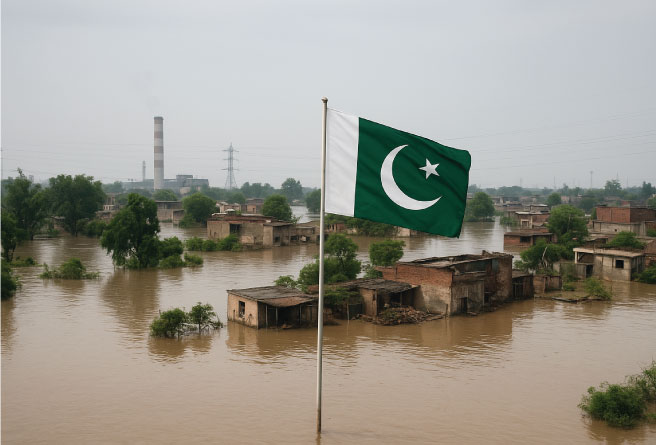Pakistan’s strategic discourse has historically and justifiably been shaped by formidable security challenges ranging from border disputes to regional rivalries and the imperative of strategic deterrence. The country has safeguarded its national sovereignty, maintaining deterrence, and created internal stability. Yet, as the security landscape evolves, one of the gravest emerging threats to Pakistan’s long-term stability is not external aggression, but the growing impact of climate change. This challenge transcends borders and calls for a broader understanding of national security, one that includes resilience against environmental and economic shocks.
Pakistan ranks among the most climate-vulnerable countries globally. When agricultural output declines and homes are destroyed, the consequences extend beyond humanitarian emergencies. Displacement intensifies urban overcrowding, unemployment, and stress on public services. In vulnerable regions, these pressures can compound socio-political tensions and threaten internal cohesion. In this context, climate change acts as a threat multiplier, exacerbating existing vulnerabilities and stretching the capacity of state institutions.
Yet climate resilience cannot be pursued in isolation. Pakistan’s economy already carries the burden of high public debt, low tax collection, and persistent inflation. Development allocations are frequently reprogrammed toward disaster relief, while long-term climate adaptation remains underfunded. This cycle weakens the state’s ability to prepare for future shocks and recover from them effectively. This is where strategic thinking must expand. National security today must go beyond traditional defense readiness to include the capacity to withstand and adapt to climate disruption. Climate-resilient infrastructure, adaptive agriculture, and inclusive urban planning are essential components of national strength, complementing, not competing with, conventional defense capabilities. A city that floods every monsoon season cannot be considered secure. A farmer displaced by drought represents a silent, strategic loss.
Recognizing that climate investment is also a form of defense, defense against instability, economic shocks, and social fragmentation, can help foster a more integrated and inclusive security doctrine. Protecting lives, livelihoods, and ecosystems enhances the very sovereignty our we are committed to preserving. Pakistan must also amplify its voice on international platforms, advocating firmly for climate justice and equitable financial support. Given its minimal contribution to global emissions and disproportionate vulnerability, Pakistan’s case for climate financing, particularly in the form of grants rather than loans, is both morally and economically justified. However, this appeal must be complemented by robust domestic reforms. Enhancing data systems, ensuring transparency in spending, and designing adaptation strategies that reflect local needs will build credibility and attract global partnerships.
A New Frontier of Security
In an era where non-traditional threats increasingly shape the global security landscape, climate change has emerged as one of the most significant and multifaceted risks to national stability. For Pakistan, a country grappling with economic volatility, evolving security demands, and high exposure to natural disasters, the convergence of environmental vulnerability and institutional capacity demands urgent attention. As climate-related events grow in frequency and intensity, their consequences extend far beyond agriculture or infrastructure.
They now influence patterns of migration, governance efficacy, and even social harmony. These dynamics, in turn, have implications for internal security and national cohesion. In this shifting context, understanding and addressing the climate-security nexus is not only prudent but also essential for comprehensive national resilience. Pakistan’s policymakers, armed forces, and civil institutions must work together to adapt to this new strategic reality, where environmental stability underpins long-term security.
Economic and Institutional Stress
Climate-related disasters in Pakistan impose heavy fiscal and institutional strain, compounding existing economic challenges. In the aftermath of the devastating 2022 floods, which displaced over 33 million people and caused estimated damages exceeding USD 30 billion, Pakistan had to mobilize substantial resources for relief and rehabilitation. According to the Ministry of Finance and UN estimates, the government spent over PKR 1.2 trillion (≈USD 4.2 billion) on flood-related expenditures in FY2023, a sum that exceeded 1.5% of GDP.
At the same time, debt servicing surged to PKR 7.3 trillion in FY2023 and is projected to reach PKR 8.2 trillion in FY2024-25, consuming nearly 47% of the federal budget. With a tax-to-GDP ratio of just 9.5% in FY2023, slightly improving to 10.4–10.8% by mid-FY2024, the country remains far from the IMF-recommended target of 13.6%. This narrow fiscal space limits the government’s ability to finance both climate adaptation and essential public services simultaneously.
More significantly, recurring climate disasters disrupt long-term development planning. Funds initially allocated to infrastructure, health, education, and clean energy often need to be reallocated to emergency relief. While this flexibility reflects the state’s responsiveness, it risks weakening institutional resilience over time. Reactive budgeting, in place of forward-looking climate investment, may delay critical infrastructure upgrades and climate mitigation projects that are essential for reducing long-term vulnerability.
Climate as a Threat Multiplier
Security analysts and development experts increasingly recognize climate change as a “threat multiplier”, a force that magnifies existing social, economic, and political vulnerabilities. In Pakistan’s context, this is not merely an academic concern but a lived reality. Climate-induced displacements, especially after floods and droughts, have accelerated rural-to-urban migration, placing intense pressure on urban infrastructure already stretched thin. Cities like Karachi, Lahore, and Peshawar are experiencing a rise in informal settlements, which often lack adequate housing, sanitation, and water supply, thereby increasing exposure to disease, economic precarity, and social friction. In regions such as Balochistan and southern Khyber Pakhtunkhwa, where livelihoods are closely tied to agriculture and pastoralism, water scarcity and shifting rainfall patterns have contributed to resource stress. In some cases, this has aggravated local grievances over land access, water rights, and employment, factors that can increase susceptibility to unrest, particularly in areas already facing governance challenges.
According to a UNDP Pakistan report (2023), the fragility of local water governance systems, combined with limited institutional capacity, has compounded these pressures. This is especially true in marginalized and climate-vulnerable communities, where inadequate adaptation measures have hindered recovery. As a result, the erosion of livelihoods and the perception of state inaction can fuel disillusionment, reducing trust in institutions and increasing the risk of instability over time. The challenge is not one of blame, but of capacity. Policymakers, civil society, and development institutions must work collaboratively to mainstream climate resilience into national security thinking. From water management and land reform to inclusive service delivery, addressing these systemic risks requires foresight, investment, and trust-building at the grassroots level.
Reframing National Security
For decades, Pakistan’s national security has rightly focused on territorial integrity and external threats. However, in the evolving post-2022 landscape, it is increasingly evident that non-traditional risks, particularly those linked to climate change, must be integrated into the broader security framework. While traditional defense remains indispensable, today’s challenges require a more multidimensional view of what it means to be secure. The National Adaptation Plan (NAP) 2023, developed by Pakistan’s Ministry of Climate Change and Environmental Coordination, marks a promising step toward this expanded understanding. It outlines strategies for disaster preparedness, water resource management, resilient agriculture, and infrastructure planning. Yet, despite its ambition, the implementation of the NAP faces serious bottlenecks. Financing remains limited, institutional coordination between federal, provincial, and local governments is inconsistent, and the capacity to absorb and utilize international climate finance is still underdeveloped.
This implementation gap must urgently be bridged. Climate resilience is no longer a purely environmental objective; it is a national security imperative. Disruptions to food systems, water availability, and energy infrastructure can destabilize livelihoods and undermine economic confidence, especially in vulnerable regions. Therefore, resilience planning must be mainstreamed into national development and security policy, with clear mandates for line ministries, disaster management authorities, and security institutions. Pakistan has an opportunity to lead by example in reframing security to include adaptation, prevention, and sustainability. This does not dilute traditional defense priorities; rather, it reinforces them by ensuring that the state has the fiscal, infrastructural, and institutional strength to respond to a wider range of emerging threats. Pakistan’s institutions have long played a vital role in safeguarding the nation’s borders and strategic interests. Going forward, their partnership in addressing climate-related risks can be a game-changer. By expanding the definition of national security to include environmental resilience, institutional preparedness, and economic stability, Pakistan can build a more comprehensive and future-ready strategy.
Integrating climate resilience into core policy planning across ministries, provinces, and sectors requires both vision and pragmatism. It also demands that climate action be seen not as a competing agenda to defense, but as a reinforcing pillar of national strength. From climate-resilient infrastructure to water governance, from early warning systems to sustainable agriculture, each investment made today reduces the risks of tomorrow. In an age where wars may be waged by droughts and displacement rather than conventional arms, Pakistan’s ability to adapt and endure will define its true strategic autonomy. The most secure nations of the future will be those that protect not only their borders, but their people, their environment, and their economy. It is time for Pakistan to lead in building that model, where defense, development, and climate security are not siloed, but synergized.
About the Author:
Hasnat Ahmad is a professional economist, columnist, and Economics Growth Officer at SRSP with expertise in fiscal policy, institutional reform, and public finance. His research and analysis focus on improving economic governance and transparency in developing countries, particularly Pakistan.

